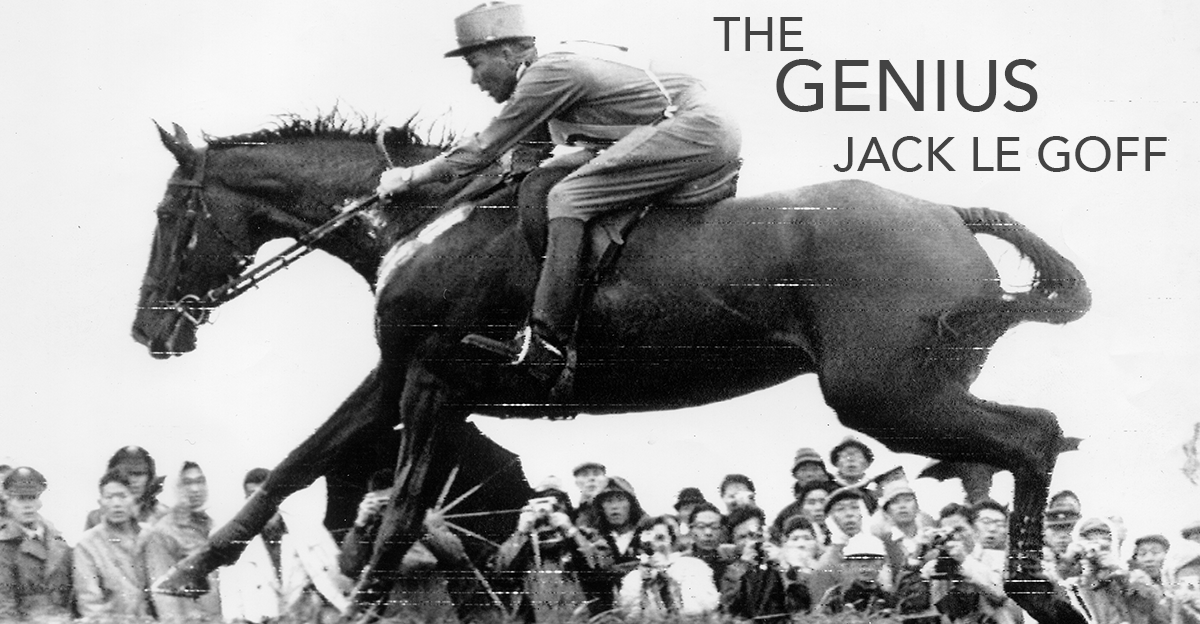
Before we published HORSES CAME FIRST, SECOND, AND LAST, I knew of Jack Le Goff. I knew of him the way any once-young-and-aspiring eventer would: through stories shared by the trainers I rode with through the years, as well as those very fine horsemen and women I’ve had the honor of working with during my tenure at TSB. He existed in my mind as a formidable individual, one who hesitated not in turning the screw in order to elicit improved performance. I knew he was a great coach, but his name caused the same quake-in-my-boots fear that George Morris’s always did…and it also raised the question that any rider with even a smidgeon of self-doubt will admit: Had I been born at the right time under the right star and found myself under his tutelage, would I have found the resolve and personal strength to flourish…to become truly accomplished in the saddle?
In HORSES CAME FIRST, SECOND, AND LAST, we hear of plenty who did flourish with Le Goff as their guide and coach. But what helps is not that they succeeded where I admittedly think I would likely have failed (in that fantasy where I am an elite rider during the heyday of US eventing), but that Le Goff shares his strategies: how and when he chose to be hard or soft, why he’d settle on keeping or losing his temper, and what his reasoning was behind decisions he made concerning coaching and the teams he led. So now we see the path to the medal, but we don’t just hear about the fences cleared, we also know about the tears, the injuries, the heartbreak. The times riders tried, and failed, and tried again. And we come to understand the passion for the horse felt by all involved, perhaps most profoundly Le Goff’s own.
Larger lessons aside, there are also hundreds of fascinating facts and historical notes throughout the book. Here are 10 that stayed with me:
1 In the notoriously hard 9-month course at the Cadre Noir, “students rode eight horses a day for a total of eight hours or more.” Le Goff writes. “For the first three months, six of those eight hours were without stirrups, so the breeches were more often red with blood than any other color…. In the evening, we had to do book work, and we all spent that time sitting in buckets of water with a chemical in it to toughen the skin.”
2 At the Olympics in 1956, the Russian eventing team only had one helmet for three riders, and passed it from one to the other after each performance.
3 Britain’s Sheila Wilcox won Badminton three times and in 1957 at the age of 21 became European Champion, but was never allowed to compete in the Olympics because she was a woman.
4 American rider Kevin Freeman helped save a horse from drowning by holding his head up in a flooded river at the Olympics in Mexico in 1968.
5 Bruce Davidson didn’t know what a diagonal was when he first started riding with Le Goff. Two years later he competed in the Olympic Games.

6 You should walk a cross-country course as if that is the ONLY time you’ll be able to walk it. You should have total concentration and envision how you will ride it. A walk simply to get a first impression is a wasted walk.
7 Today, people learn to compete before they learn to ride, and that makes it difficult for them to be truly competitive and to progress to other levels.
8 There is no instant dressage like instant coffee. You can go out and buy a top-level horse if you have enough money, but the true rider should be able to “make” his or her own horse. In eventing, there are often “pilots” who “fly” or ride the horse, and mechanics who prepare him, train and condition him. But the true horseman does both.
9 Although he was a brilliant rider, Tad Coffin did not believe how good he was, so while Le Goff would intentionally infuriate some riders to get them to perform, he would instead look for ways to give Tad confidence.
10 The riding coach who is looking to be popular will not produce the desired results, and the rider who does not accept discipline “may be better suited to another pursuit,” Le Goff writes. “Crochet comes to mind!”
I’m certain you’ll find many other tidbits that motivate you or make you laugh or look at your riding differently in this book. Most importantly, by reading Le Goff’s book, you, too, will be able to share his stories and spread his philosophy. And through us all, the best of Jack Le Goff, the man George Morris called “a genius,” will live on.
HORSES CAME FIRST, SECOND, AND LAST is available from the Trafalgar Square Books online bookstore, where shipping in the US is FREE.
CLICK HERE for more information or to order.
—Rebecca Didier, Managing Editor
Trafalgar Square Books, the leading publisher of equestrian books and DVDs, is a small business based on a farm in rural Vermont.

